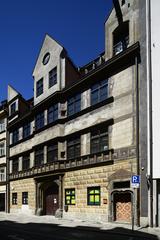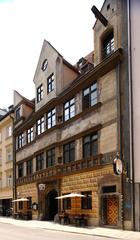
Weinstadl Munich Visiting Hours, Tickets, and Historical Sites Guide
Date: 14/06/2025
Introduction
Nestled in Munich’s historic Altstadt, the Weinstadl (München) stands as a testament to the city’s medieval origins, rich wine trade heritage, and architectural evolution. With roots dating back to the early 16th century, the Weinstadl evolved from a municipal wine depot into the city scribe’s administrative center, reflecting both economic growth and urban sophistication during the Renaissance. Today, it continues to thrive as a cherished venue, blending historic ambiance, culinary delights, and cultural events. This comprehensive guide details the Weinstadl’s history, architecture, visiting hours, ticket information, accessibility, and practical tips for an authentic experience (Wikipedia; MuenchenWiki; Komoot; Ganz München; muenchen.de; Culture Tourist).
Table of Contents
- History & Evolution
- Architectural Highlights
- Visiting the Weinstadl
- Visitor Experience & Practical Tips
- Frequently Asked Questions (FAQ)
- Conclusion
- References
History & Evolution
Medieval Origins
Constructed around 1525 as a Gothic-style Bürgerhaus, the Weinstadl was a typical urban residence for Munich’s affluent burgher class (Wikipedia). Its establishment coincided with a period of economic growth and urban expansion, as Munich’s population and importance increased from its founding in 1158 (Introducing Munich). By 1550, the city acquired the property at Burgstraße 5 (and adjoining Dienerstraße 20) to establish a municipal wine depot and city scribe’s office, reflecting the importance of the wine trade in Munich’s economy (MuenchenWiki).
Stadtschreiberei Transformation
Between 1551 and 1552, under master mason Hans Aerenhofer the Elder, the Weinstadl was remodeled for administrative use as the Stadtschreiberei (city scribe’s office), retaining key Gothic features such as the arcaded courtyard (Laubenhof) and the spiral staircase tower (Treppenturm mit Schnecke) (Komoot; Ganz München). In 1552, renowned painter Hans Mielich adorned the façade with Renaissance ornamentation, much of which has been restored (Wikipedia). The Weinstadl functioned as the seat of the Stadtschreiberei until 1612, solidifying its role in civic life.
Later Uses & Ownership
After the administrative offices moved in 1595, the Weinstadl continued to serve municipal and commercial functions. The city sold the property in 1622 but retained wine cellars for ongoing trade (MuenchenWiki). It passed through private hands and was the site of significant intellectual gatherings, including the inaugural meeting of the Bavarian Academy of Sciences in 1758.
Restoration & Preservation
Severely damaged in World War II air raids, the Weinstadl underwent careful reconstruction starting in 1951 under architect Siegfried Schmelcher, with further façade restorations in the 1960s and interior renovations in the 1990s (Komoot; Wikipedia). It is now a protected monument listed on the Bavarian register of historic buildings (Bayerische Denkmalliste).
Architectural Highlights
- Arcaded Courtyard (Laubenhof): A rare medieval urban courtyard, offering insight into domestic and commercial life (Ganz München).
- Spiral Staircase Tower (Treppenturm mit Schnecke): The last surviving non-religious Gothic spiral staircase in Munich (Komoot).
- “Himmelsleiter” (Jacob’s Ladder): A unique architectural motif, preserved in the city (Wikipedia).
- Façade Paintings by Hans Mielich: Restored Renaissance artwork that enhances the building’s historical allure (Wikipedia).
Visiting the Weinstadl
Opening Hours & Tickets
- Restaurant & Courtyard: Access is primarily during restaurant hours, typically Monday to Saturday, 11:30 AM–11:00 PM; Sunday, 12:00 PM–9:00 PM. The courtyard is open for dining during these times.
- Admission: Entry is free with restaurant patronage or during events. Guided tours may have separate fees; check with local tourism providers for schedules and prices.
- Guided Tours: Available through the Munich Tourism Office, especially as part of Altstadt historical tours (Munich.de).
Accessibility
- Wheelchair Access: Ground-level areas, including the courtyard and restaurant, are generally wheelchair accessible. Historic upper levels or cellars may have limited access; inquire ahead if you have specific needs.
- Facilities: Restrooms are available, and most venues accept both cash and cards. Carry some cash for small purchases or tips (exiap.com).
Nearby Attractions
- Viktualienmarkt: Munich’s vibrant food market.
- Marienplatz: The central square, home to the New Town Hall and Glockenspiel.
- Frauenkirche: Munich’s iconic cathedral.
- Hofbräuhaus: Legendary beer hall, offering a different facet of Bavarian hospitality.
Guided Tours & Events
The Weinstadl regularly hosts special events, wine tastings, and seasonal celebrations. Booking guided tours in advance is recommended, especially during Oktoberfest or Christmas markets (Culture Tourist).
Visitor Experience & Practical Tips
- Dress Code: Casual attire is the norm; traditional Bavarian dress is welcome during festivals (travelvagabonds.com).
- Menu: Expect a selection of regional wines (Franconian and Bavarian), local beer, and Bavarian specialties such as sausages, pork roasts, pretzels, and vegetarian options.
- Customs: Tipping 10–15% is standard; sharing tables is common and part of the local Gemütlichkeit (exiap.com).
- Language: Staff typically speak German and English; menus are usually bilingual.
- Photography: Allowed in public and dining areas; always ask before photographing staff or guests.
- Connectivity: Free Wi-Fi is common, but not universal; digital payments are widely accepted.
- Best Times to Visit: Weekdays for a relaxed atmosphere; weekends and festival times for lively events.
- Safety: Munich is generally safe; use standard precautions and keep belongings secure (nomadicmatt.com).
Frequently Asked Questions (FAQ)
Q: What are the Weinstadl’s opening hours?
A: Generally during restaurant hours: Mon-Sat 11:30 AM–11:00 PM, Sun 12:00 PM–9:00 PM. Some venues open for tours 10:00 AM–6:00 PM; check ahead for variations.
Q: Is there an entry fee?
A: Entry is free with restaurant patronage; guided tours or special events may have separate charges.
Q: How do I get there?
A: Centrally located in the Altstadt, near Viktualienmarkt. U-Bahn: Marienplatz or Sendlinger Tor; Tram: Lines 19/21; Bus: Several city lines.
Q: Is Weinstadl wheelchair accessible?
A: Ground-level areas are accessible; historic sections may have limitations. Contact the venue for details.
Q: Are children welcome?
A: Yes, during the day. Evenings are more adult-oriented.
Q: Can I make a reservation?
A: Strongly recommended, especially during weekends, festivals, or large group visits. Online booking is often available.
Conclusion
The Weinstadl is a living monument to Munich’s layered history—an architectural treasure where Gothic, Renaissance, and modern hospitality converge. Whether you’re enjoying a regional wine, exploring medieval architecture, or joining a guided tour, the Weinstadl offers an authentic and enriching encounter with Bavarian tradition. Its central location, accessibility, and immersive atmosphere make it an essential stop on any Munich itinerary.
For the latest visiting hours, ticket details, and special events, consult official resources or the venue’s website. Enhance your experience by downloading the Audiala app for real-time updates, interactive tours, and insider tips on Munich’s historical and cultural gems.
References and Official Links
- Weinstadl – Wikipedia
- Weinstadl – MuenchenWiki
- Weinstadl Historical Highlights – Komoot
- Weinstadl Architectural Features – Ganz München
- Munich Tourism – muenchen.de
- Bavarian Cultural Sites – Culture Tourist
- Munich City Guide – Germany Travel
- Munich Public Transport Tips
- Nomadic Matt: Munich Travel Guide
- Exiap: Spending Money in Munich
- Travel Vagabonds: Munich Packing List






































































































